

In June 1940 Lithuania was annexed to the Soviet Union and became a Soviet Republic. Following new rules, the majority of the shops belonging to the Jews of Shat were nationalized and commissars were appointed to manage them. Also several Jewish houses whose area was more than 220 square meters were nationalized and their owners forced to vacate them. All the Zionist parties and youth organizations were disbanded and Hebrew educational institutions were closed. Some Jewish youth integrated into the new regime and became members of the Comyug (Communist Youth Organization).
In the Yiddish newspaper Shtraln ("Rays") of the tenth of August 1940, a reportage was published by the Shater A. Garun about the festive meeting on the occasion of the integration of Lithuania into the family of the great USSR which took place in Shat on Sunday the fourth of August with the participation of about 3,000 people. There were songs and dances and among others M. Kurliandschik delivered a speech as the secretary of the local Comyug, Y. Grinblat in Yiddish on behalf of the peoples committee and Sh. Kurliandschik on behalf of the Comyug organization.
Supply of goods decreased and, as a result, prices soared. The middle class, mostly Jewish, bore most of the brunt, and the standard of living dropped gradually. Many families remained without any income. In the middle of June 1941 Shimon Bernshtein and his wife were exiled to Siberia. After 30 years, in 1971 they returned to Vilna where, 2 years later, he passed away.
In 1940 there were about 250 Jews of the total population of 1450 in town.
It should be mentioned that despite all their hardships and poverty, the Jews of Shat never lost their sense of humor, their determination, and their togetherness.
When the German Invasion began on Monday 23rd June 1941, local Lithuanians were already armed and on the rampage, and terror spread amongst the Jews. Their fear was great. The younger people tried to escape to the town of Vilkomir, but were intercepted by the armed Lithuanians who poured out of the forests, and brutally forced the young Jews to return to Shat.
On Tuesday morning 24th June, German tanks arrived from the direction of Keidan and were met by large forces of the Russian Army, resulting in a bitter battle. The Jews fled from their homes with nothing but the clothes on their backs. Some of them congregated next to the Jewish cemetery, and some escaped to the estate of Aba Ziv, about 6 km from Shat. Others tried to find refuge with local farmers known to them. Only a score of people remained in the village itself.
The first act of the Germans was to round up Yehoshua Aharon Levi, a respected local Jew. They took him to the Synagogue and ordered him to tear the Torah scrolls. When he refused, they shot and killed him.
The Lithuanian activists, together with the Germans, then went from house to house and forcefully assembled the remaining Jews for hard labor. They were tortured and beaten cruelly. Those Jews who had found shelter amongst known local farmers were forced to leave.
Each day, some Jews returned to their village, but they were killed by the wild mobs.
Old people were dragged out of their homes, tortured and then passed on to the two village madmen, who paraded them through the village, and on to the neighboring village of Vilkalnai, where most of them were murdered.
On the 20th August, the remaining Jews were rounded up, put on trucks and taken to Keidan. At the same time, all those who had hidden on Aba Ziv's estate, including Aba Ziv himself, were also trucked to Keidan. Together with the Jews of Keidan and other villages of the area, (Zeimiai and others) they were held under terrible crowded conditions for thirteen days at the Zirginas, riding school stables.
Except for so called "coffee" they were not fed, the men being taken daily to various forced labor works.
Meanwhile Russian prisoners of war had dug a massive pit on the banks of the Smilga stream.
On the 28th of August they were taken to the pit. The first group of 60 old people were thrown mercilessly into it and fired upon by the Lithuanians with automatic weapons.
Of the next group of 60, some of the Jews of Keidan and Shat resisted, inflicted wounds on some of the murderers and fought until the end.
To avoid any further resistance, the next groups were reduced to 20 victims, for easier control. The last groups were mothers and their children. The mothers and older children were shot and the infants were used as balls by the Lithuanians, being thrown from one to the other and then thrown alive into the pit.
The Russian prisoners were made to throw lime over the bodies, many of them still moving. After the pit was covered, the ground heaved from the mass of victims still being alive. The Germans brought steamrollers to flatten the surface and subdue the victims.
Involved in this massacre were two Lithuanians from Shat (their names are held at the archives of Yad Vashem).
According to the Yaeger Report, a total of 2,076 persons were murdered there; however, the correct figure is bound to be more.
After the war, the few survivors of Keidan and Shat placed a Memorial Stone on the Communal Grave, inscribed in Yiddish, Russian and Lithuanian, which stated: "Victims of the Fascist Terror".
In the nineties the tablet was replaced by a new one with the
inscription in Yiddish and Lithuanian: "Here the Hitler murderers with their
local helpers on 28.8.1941 murdered 2076 Jews."
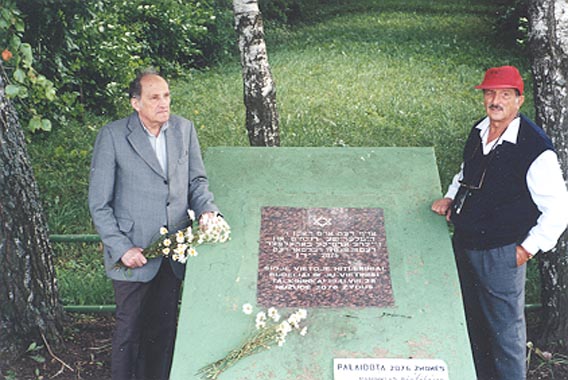
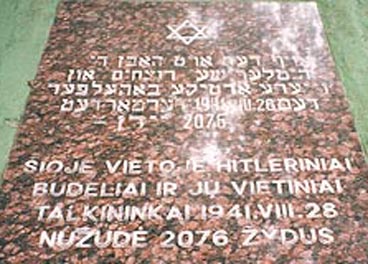
The Jewish cemetery was erased during the Nazi rule and the
tombstones used by the Lithuanians for building purposes. [Ada Green's
note: according to elderly Lithuanians currently living in Seta, the Jewish
cemetery was erased during the Communist rule in 1949 and the tombstones used by
the Russians for building purposes]. The photos below show the cemetery as
photographed in 1937 and the empty site with the monument as photographed in the
nineties.
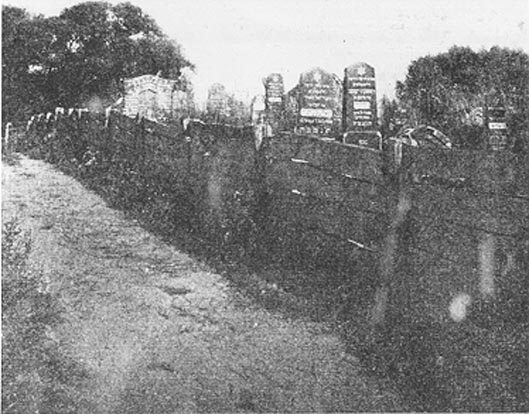
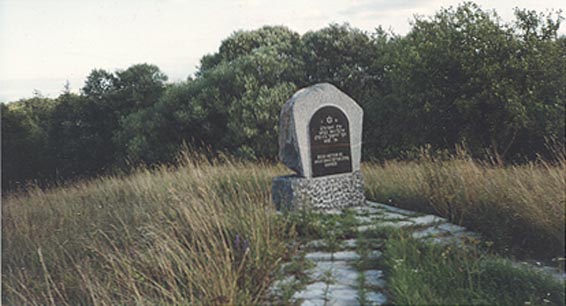
Photograph of the wall bearing the name of Shat (Seta) in the "Valley of the Communities" in Yad Vashem, Jerusalem, see the "Seta Photo Gallery" below.
The survivors of Shat Jews were: Khaim Burshtein, who managed to join the partisans in the forest near Keidan; the brothers Shlomo and Manes Kurlandchik, Khaim Mankovitz, Avraham Garun and David Rotblat who escaped to Russia and fought the Nazis in the Lithuanian division of the Red Army. Kh. Mankovitz and Manes Kurliandschik fell in battle.
The following also survived: the sisters Mirah and Liuba Vidutsky, who had successfully escaped from the Kovno Ghetto and remained in hiding.
Leah Aizikovitz and Sarah Grinblat, having been sent to Stutthof concentration camp from Kovno.
Tuviah Goldberg was another still alive when the Ghetto was emptied.
Fruma Bernshtein, Yehudith Kamod and Rachel Yankelevitz also emerged alive, having been in Russia during the war.
For the list of Shat Jews before WW2, as prepared by Shlomo
Kurliandschik, see Appendix 3.
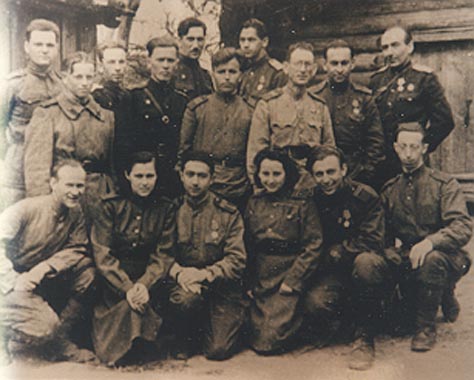
Three Shatter born young men, Sydney Levy (Gaddie), Hymie
Schachman and Joseph Woolf came with the 800 South African volunteers to
participate in Israeli's War of Liberation 1948/49.
Bibliography
The Small Lithuanian Encyclopedia, Vilnius 1966-1971 (Lithuanian).
The Lithuanians Encyclopedia, Boston 1953-1965 (Lithuanian).
Lite, Volume 1, New York 1951 (Yiddish).
Yahadut Lita, Tel-Aviv, Volumes 1-4 (Hebrew).
Yad-Vashem Archives: 0-3/2276; M-33/989; M-1/E-1509/1415; 1700/1569.
Koniuchovsky Collection 0-71, File 40.
Central Zionist Archives: 55/1788; 55/1701; 13/15/131; Z-4/2548.
YIVO, New York, Lithuanian Jewish Communities Collection, File Keidan, pages 44179, 44200, 44201, 44247, 44248.
HaMelitz (St. Petersburg): 26.8.1887; 13.2.1888; 28.4.1897;12.7.1898; 21.1.1900; 1.8.1903 (Hebrew).
Kagan, Berl, Shtet, Shtetlach un Dorfishe Yishuvim in Lite biz 1918 (Towns, Small Towns and Rural Settlements in Lithuania till 1918), New York 1992 (Yiddish).
Folksblat, Kovno: 17.7.1935 (Yiddish).
Di Yiddishe Shtime (The Yiddish Voice) Kovno: 18.7.1933 (Yiddish).
Yiddisher Hantverker (Jewish Artisan) Kovno: Nr.3, 1938 (Yiddish).
Masines Zudynes Lietuvoje (Mass Murder in Lithuania) Volumes 1-2, Vilnius 1941-1944 (Lithuanian).
Pinkas HaKehillot Lita (Encyclopedia of Jewish Settlements in Lithuania), Editor: Dov Levin, Assistant editor: Yosef Rosin, Yad Vashem, Jerusalem 1996 (Hebrew).
Yahadut Lita, The Rav Kook Institution, Tel-Aviv 1959.
The Book of Sorrow, Vilnius 1997 (Hebrew, Yiddish, English, Lithuanian).
Shat. Its history and destruction, unpublished article by Shlomo Kurliandschik.
Eliahu ben Yakov Ragoler (1794-1849) who served as rabbi in 1821 and who also established the large yeshiva of Slobodka in Kovno;
Naftali bar Ephraim;
Meir-Mikhel Rabinowitz (1830-1901) who served in Shat for 20 years, author of the book HaMeir L'Olam, published in Vilnius, 1903, on the logic system of studying the Torah;
Nahum Shapiro (1818-1902) prodigy of Rabbi Israel Salanter;
Zev-Wolf Avrech (1845-1922) served in Shat in 1875;
Avraham Druskowitz (served Shat 1897-1902);
Shlomo-Dov Hacohen Shprintz served in Shat in the 1890's;
Shlomo son of Meir-Mikhel Rabinovitz (served in Shat from 1903), died 15 July 1933 (15 Tamuz), age 63, as per entry in the metrical register of the Kedainiai Rabbinate, Central Metrical Archives, Vilnius;
Elkhanan Wiener, the last Rabbi of Shat, murdered in 1941.
Rabbi Yehoshua Rabinovitz (1818-1887), son of Eliyahu Ragoler, from 1847 head of the yeshivah of Kletsk;
Rabbi Moshe-Itzhak Rabin (1834-1902) who served for 40 years as the authorized rabbi of Ponevezh and for many years the principal of the famous Ponevezh Yeshiva;
Ben-Zion Shater, head of a Yeshiva in Vilna during the 1880's;
Shmuel ben Meir-Mikhel Rabinovitz, Rabbi in U.S.A., published in Hatsefirah complex problems in geometry, died 16 September 1925 (27 Elul 5685).
Mordechai-Manes Monashevitz (1857-1927), an educator and author who founded a well-known school in Liepaja, Latvia, which existed for 38 years. From 1919 in the U.S.A., where he became a school teacher and latterly in New York. From 1870, publisher of poems, essays, Hebrew educational books and plays;
Meir-Yitshak Goldberg (born 1871), Rabbi in Ostrova and Vitebsk;
Ephraim Kaplan (1879-1943) who emigrated to the U.S.A. in 1904, published articles on historical issues and edited Der Morgen Journal (The Morning Journal) in New York;
Yb"a Ziv, lived in the second half of the nineteenth century, writer of novels in Yiddish and also poems in Hebrew.
| Nr. | Surname | Name | Wife | Children | Remarks |
| 1 | Beten | Shlomo | + | 2 sons | blacksmith |
| 2 | Kurliandschik | Khayim | Masha | Shlomo, Manes, Khanah | |
| 3 | Milner | Shaye | Sore Etel | Pesia, Volf & grandmother1 | |
| 4 | Garun | Avraham | ---------- | sister Esther and mother | |
| 5 | Yankelevitz | Meir | Rachel | mother | |
| 6 | Khases | Leib | + | ||
| 7 | Grinblat | Lipe | + | daughter and husband2 | tailor |
| 8 | + | -------- | Khane-Base3 | Fradke | |
| 9 | Goldshmidt | Manes | Khasi-Beile | Khaya, Keile Rivka, Libe, Tila, Jakob-Mendel and 5 other children | |
| 10 | Randman | Chone | Chiene | son Mikhael4 | from 1938 in USA |
| 11 | Vidutsky | Eli | Reizl | Miriam, Liuba, Khanah, Avraham | |
| 12 | Aizik | ------ | 2 daughters | ||
| 13 | Meir | Sara | carpenter | ||
| 14 | Vulf | Yankel | Sheina-Taube | Elke, Pesia, Shmuel | |
| 15 | Goldberg | Markus | Dobre | Tuvia, Nakhman | |
| 16 | Khatskel5 | Khayah | the Shamash | ||
| 17 | Kurlandshik | Shimon | Simche | Aizik, Base, Yente | |
| 18 | Strazh | Hirshel | Khanah | ||
| 19 | + | + | 2 daughters | shoemaker | |
| 20 | Meike | + | tailor | ||
| 21 | Blekher | Berl, Yekhiel, Ester-Malka, Yankel, Efrayim | |||
| 22 | Beile | with mother | |||
| 23 | 3 brothers | grain merchants | |||
| 24 | Reznik | Khayim | + | 1 daughter | Shokhet |
| 25 | Ginsburg | Mendel | + | Yokheved | |
| 26 | Bernshtein | Zalman | Sonia | ||
| 27 | Grinblat | Yankel | Sarah | Aharon, mother-in-law | |
| 28 | Burshtein | Itsik | Roza | Khayim, Shimon, Zelda, Leah | |
| 29 | Khana-Rachel | Aba, Bath-Sheva, Pesia | |||
| 30 | Balatin | Barukh | sister Ita | ||
| 31 | Aron | Feivel | + | Bela, Kopel | blacksmith |
| 32 | Kurliandchik6 | Leib | + | Mina | |
| 33 | Lurie | Alter | Sora | Moshe7 | |
| 34 | Kamod | Beile | Minke | ||
| 35 | Levin | Aharon | + | Reuven, Shmerl, Moshe | |
| 36 | Raizman | Meike, Feigele8 | |||
| 37 | Land | Matle | Yitzkhak, Shmuel David | ||
| 38 | Yankelevitz | Pesia9 | mother | ||
| 39 | Yonah, David, 2 sisters | ||||
| 40 | Bernshtein | Yeizel | Toibe | Tuvia, Shimon, Fruma, Tsipora, Sheva, Khanah | |
| 41 | Glass | Aharon | + | Rachel, Leah, Rivkah, Shlomo, Barukh | |
| 42 | Rotblat | David | brother Nathan, father and mother | ||
| 43 | Riklis | David | Blume | Henakh, Sore10 | |
| 44 | Kidesh | Aba | father and mother | ||
| 45 | Mankovitz | Khayim | mother Feigel | ||
| 46 | Tubiansky | Gershon11 | + | tailor | |
| 47 | Kagan | Volf | + | Rachel, Avraham | |
| 48 | Aizikovitz | Nokhim | Hinde-Gitel | Leah, Rivkah | |
| 49 | Sadinsky | Alter | Esther, Golda, father, mother | ||
| 50 | + | + | daughter | shoemaker | |
| 51 | Leib | barber | |||
| 52 | Shnaid | Nakhman, Pesakh12 | |||
| 53 | Rabinovitz | widow13 | 3 daughters | Rabbi |
All together are in this list 195 names. Mr. Shlomo
Kurliandschik estimates that there were may be about 30-40 more Jews in town he
couldn't remember. Joe Woolf contends that there were even more. About 94% were murdered.
Notes added by Ada Green:
1Shaye Milner and Sore Etel nee Kurliandschik also had son David Nisan.
2Lipe Grinblat's daughter's name was Zelda, the
wife of David Schwartz. They had a daughter, Chase, and a son, Chonel. Lipe
Grinblat was also the father of Yankel (Nr. 27 above), in addition to another
son, Aron (the husband of Chana). Aron and Chana lived in Kaunas.
3This could be Khana-Base Vinik, wife of Elias Vinik. If so,
they also had a son, David Leib Vinik.
4Chone Randman and wife Chiene nee Rogalsky also had daughters
Leah and Roche.
5There was a Chatzkel Kan
and wife Khayah nee Skurkovich (Khayah died in 1936). They had a daughter
Feige.
6There was a Leib Kurliandschik, wife Feigele nee Shachman, and daughter Khayah.
7Alter Lurie and wife Sora nee Altmuner also had children
Rachil and Benjamin.
8Meike (Meer Vulf) and Feigele Raizman also had sisters Etel, the wife of Chaim Yofe, and Tamara. Their
parents, Chaim Leib Raizman and Rochel nee Grinblat, were probably also still living. Meike Raizman was the husband of Khaya nee Klor.
9There was a Chaim Yankelevich and wife Frume nee Meltzer with daughter Pese.
10David Riklis and Blume nee Bank also had son Abram and a
daughter Nese, who was married to Hilel Segal.
11There was also a Chaim-Leizer Grinblat and wife Roche-Zlate
nee Tuviansky with children Hertz Yosel, Gershon, and Shifre-Leah. Chaim-Leizer Grinblat also had a sister, Frieda, who was married to a man named Bloomberg (first name unknown). They were the parents of twin infants.
12There was an Izrael Shnaid and wife Yente nee
Kapulnik, with sons Manes and Pesakh.
13The widow of Rabbi Shlomo Rabinovitz was Rochel, daughter of
Movsha Meltzer. Her daughters were Sora Sheina, Leah Rasha, and Gitel. She also
had a son, Chaim. Click here for pre-war photos of the Rabinovitz family.
Copyright © 2000-2011 Joseph Rosin